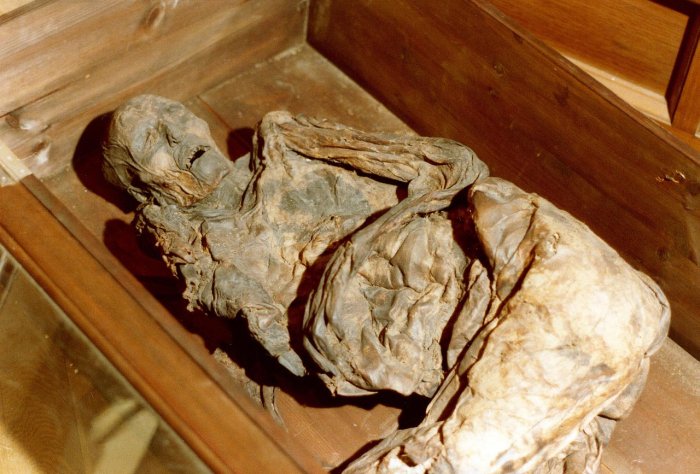Mystery Of The Haraldskærkvinnan (Haraldskærwoman) – Bog Body Of A Viking Queen?
Ellen Lloyd - AncientPages.com - The discovery of an ancient bog body in Denmark tells the story of a woman who journeyed to an unknown land only to meet death, but why? Was she sacrificed? Could she have been a deceived Viking Queen? It seems the story is a little more complicated than this.
Credit: Adobe Stock - D3N Pics
Scientists have long tried to unravel the mystery of the bog body today known as Haraldskærkvinnan (Haraldskærwoman). With the help of historical records, archaeological investigations, and modern technology, it has been possible to shed a more comprehensive picture of events that took place more than 2,000 years ago.
The Discovery Of The Haraldskærkvinnan
Everything started on October 30, 1835, when two ditch diggers discovered a well-preserved preserved female body in muddy water in Haraldskær bog, just outside Vejle, Denmark. Tree hooks and branches held the naked, dead body under the water. A furrow around the neck may indicate that she was strangled before being placed in the bog.
The body was transported to the Vejle Hospital for examination. At the time of the discovery, her skeleton was estimated to be from around 490 B.C. She was described as approximately 150 cm in height and around 50 years old. Her hands and feet showed no signs of extensive physical labor. However, her teeth were noticeably worn out.
Who was the woman? Why was her story?
The Haraldskærkvinnan was buried with three woolen outfits, a leather cloak, a hat with dangling cords that covered her hair, and multiple woolen cords. Various components of her clothes were locally produced, while others were made from materials originating from different locations. Contemporary scholars interpret this as an indication of her high social rank and that she was wealthy. Historians suggested she had extensive connections and likely traveled throughout the southern regions.
Was Haraldskærkvinnan A Viking Queen?
Unfortunately, it was wrongly assumed that the Haraldskærkvinnan was Queen Gunhild, a Norwegian Viking queen and widow of Eric Bloodaxe. She was believed to have been lured to Denmark by Harald Bluetooth with a marriage proposal but met her end by drowning in a bog. However, Jens Jacob Asmussen Worsaae, a well-known archaeologist from Vejle employed at the National Museum in Denmark, has proven this theory incorrect.
DNA Analysis Of The Haraldskærkvinnan
Later studies based on strontium isotope analysis revealed the bog body belonged to a local woman who made a long journey shortly before her death.
According to Karin Margarita Frei from the National Museum, who was responsible for the investigations in collaboration with the Vejle Museums and researchers from CTR at the University of Copenhagen and the Moesgaard Museum, the Haraldskærkvinnan may have been from central Germany, the north-western Czech Republic or the western part of Scotland.
Despite her advanced age of more than 2,000 years, some of her 50 cm long hair was still found, and it was also possible to study her skin, teeth, and woolen garments.
Bog body of the Haraldskærkvinnan. Credit: vejlemuseerne
"I can see from the hair closest to the scalp that the isotope values for the last five months of her life match those for a place with volcanic rocks far from Denmark. She must have returned to Jutland very shortly before her death because the values in the hair have not changed", says Karin Margarita Frei.
Frei was also behind the groundbreaking research results on the Egtved girl, which showed that she was not from Denmark at all but came from a place many hundreds of kilometers from the Egtved region.
"I have analyzed the tooth enamel on one of Haraldskærwoman's front teeth, which functions as an archive of what she has eaten and drunk in her childhood from when she was approximately three to seven years old. The strontium isotope analyses show that she most likely stayed in Jutland during that period, which leads to the assumption that she may also have been born there, she says and continues:
In addition, the oldest part of her hair revealed that she stayed in Jutland four years before her death," Frei explained.
The Haraldskær Woman holds the distinction of being the first mummified body discovered in Denmark. In 1835, when she was found, there were no established protocols for handling and preserving such remains. Unfortunately, due to a lack of preservation methods post-autopsy, her body has significantly shrunk over time. Presently, she stands at approximately 135 centimeters tall. However, according to researcher Charlotta Lindblom at the Vejle Museum, she would have been initially around 150 centimeters tall during her lifetime.
Today, Haraldskærkvinnan is on display at the Vejle Museum. It remains unknown how and why she ended up on bog. It is possible she was sacrificed.
Scientists say it appears to be a common practice, possibly influenced by Celtic traditions, to offer human sacrifices in the centuries preceding Christ's era. Bogs were often seen as transitional spaces between water and land - gateways from our world to the spiritual realm.
These sacrifices were typically made with hopes of receiving blessings such as abundant fertility or bountiful harvests. According to Mads Rav at the Vejle Museums, similar sacrificial customs can be traced from Northern Germany to England.
The phenomenon of bog bodies in Europe has long intrigued the scientific community. Numerous bodies have been unearthed across various European nations, impeccably preserved due to the cool, acidic environment and organic compounds in the bogs. However, despite rigorous research efforts, it is only recently that a comprehensive understanding of this phenomenon has been achieved.
Bog body of the Huldremose woman. Image credit: Sven Rosborn
An international team of archaeologists has conducted an extensive analysis of hundreds of ancient human remains discovered within Europe's wetlands. Their findings reveal that these "bog bodies" were part of a longstanding tradition extending over several millennia. Individuals were interred in bogs from prehistoric times right up until the early modern era. Furthermore, their research indicates that where a cause of death could be ascertained, most individuals appear to have met with violent ends.
Scientists point out that earlier studies of the skin of another bog woman, the Huldremose woman, showed that she, too, had been on a journey shortly before her death. Combined with the new knowledge about Haraldskærkvinnan, it might help to answer why these people were buried in the marshes and whether traveling, for example, had something to do with a specific ritual.
We may learn about the Haraldskærkvinnan one day, but for now, it is enough to say she was not a Viking Queen.
Written by Ellen Lloyd - AncientPages.com
Copyright © AncientPages.com All rights reserved. This material may not be published, broadcast, rewritten or redistributed in whole or part without the express written permission of AncientPages.com
Expand for referencesMartin Frank - Mysterier från mossen: Mosslik från Danmarks järnålder och deras relevans idag, Uppsala Universitet, Instutionen för arkeologi och antik historia, VT 2023
Nationalmuseet i København - Jysk kvinde foretog lang rejse, før hun endte som moselig
National Geographic - Ancient Bodies: Secrets revealed
Jan Bartek - Mystery Of Europe’s Bog Body Phenomenon Solved By Scientists - AncientPages.com
More From Ancient Pages
-
 Revealing 1,200 Years Of Arctic Canadian Cultures And Settlements In Canada
Archaeology | Jul 11, 2024
Revealing 1,200 Years Of Arctic Canadian Cultures And Settlements In Canada
Archaeology | Jul 11, 2024 -
 Ruins Of 2,300-Year-Old City Of Jiaohe On The Silk Road
Civilizations | Aug 6, 2023
Ruins Of 2,300-Year-Old City Of Jiaohe On The Silk Road
Civilizations | Aug 6, 2023 -
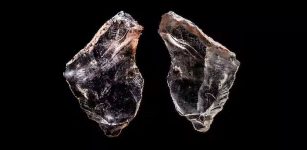 65,000-Year-Old ‘Stone Swiss Army Knives’ Show Early Humans Had Long-Distance Social Networks
Archaeology | Oct 22, 2022
65,000-Year-Old ‘Stone Swiss Army Knives’ Show Early Humans Had Long-Distance Social Networks
Archaeology | Oct 22, 2022 -
 Artifacts And Long History Of Unguja Island – Ancient Humans Impact Island’s Environment
Archaeology | Mar 5, 2022
Artifacts And Long History Of Unguja Island – Ancient Humans Impact Island’s Environment
Archaeology | Mar 5, 2022 -
 King David-Era Fort Unearthed In Golan Heights Sheds Light On Aramean Kingdom Of Geshur
Archaeology | Nov 14, 2020
King David-Era Fort Unearthed In Golan Heights Sheds Light On Aramean Kingdom Of Geshur
Archaeology | Nov 14, 2020 -
 Abydos: One Of The Most Important Cities Of Ancient Egypt
Civilizations | Jul 15, 2016
Abydos: One Of The Most Important Cities Of Ancient Egypt
Civilizations | Jul 15, 2016 -
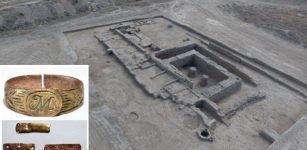 Stunning Ancient Khanqah With Large Underground Crypt, Ritual Halls And Burials Discovered In Turkestan
Archaeology | Aug 14, 2020
Stunning Ancient Khanqah With Large Underground Crypt, Ritual Halls And Burials Discovered In Turkestan
Archaeology | Aug 14, 2020 -
 Supernatural Beliefs Of Medieval People – From Elves And Fairies To Abductions And The Undead
Featured Stories | Nov 1, 2024
Supernatural Beliefs Of Medieval People – From Elves And Fairies To Abductions And The Undead
Featured Stories | Nov 1, 2024 -
 When Giants Ruled North America – Giant Skeletons ‘Erased’ From History – Part 2
Civilizations | Nov 22, 2018
When Giants Ruled North America – Giant Skeletons ‘Erased’ From History – Part 2
Civilizations | Nov 22, 2018 -
 Secrets Of A Lake That Could Re-Write Ancient History Of America – Interesting Artifacts And Buildings – Part 2
Artifacts | Jun 5, 2018
Secrets Of A Lake That Could Re-Write Ancient History Of America – Interesting Artifacts And Buildings – Part 2
Artifacts | Jun 5, 2018 -
 Historical Artifacts Found In The Mammoth Cave’s Mysterious Passageway
Archaeology | Jul 12, 2022
Historical Artifacts Found In The Mammoth Cave’s Mysterious Passageway
Archaeology | Jul 12, 2022 -
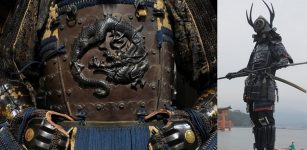 Ancient History Of The Samurai Armor
Featured Stories | Aug 27, 2018
Ancient History Of The Samurai Armor
Featured Stories | Aug 27, 2018 -
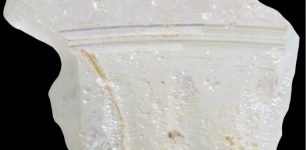 New Method Distinguishes Between Egyptian And Palestinian Glass During Roman Times
Archaeology | Jul 13, 2020
New Method Distinguishes Between Egyptian And Palestinian Glass During Roman Times
Archaeology | Jul 13, 2020 -
 Athena – Goddess Of Wisdom Delivered Punishments And Gifts
Featured Stories | Dec 31, 2018
Athena – Goddess Of Wisdom Delivered Punishments And Gifts
Featured Stories | Dec 31, 2018 -
 Ancient Burials Shed New Light On Earliest Humans In Indonesia
Archaeology | Aug 25, 2022
Ancient Burials Shed New Light On Earliest Humans In Indonesia
Archaeology | Aug 25, 2022 -
 Migrants From Turkey And Greece Arrived In Britain Some 6,000 Years Ago
Archaeology | Apr 16, 2019
Migrants From Turkey And Greece Arrived In Britain Some 6,000 Years Ago
Archaeology | Apr 16, 2019 -
 What Are The Most Common Misconceptions About Pirates?
Ancient History Facts | Apr 16, 2024
What Are The Most Common Misconceptions About Pirates?
Ancient History Facts | Apr 16, 2024 -
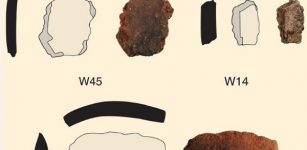 3,000-year-old pottery found in Papua New Guinea’s highlands
News | Sep 3, 2015
3,000-year-old pottery found in Papua New Guinea’s highlands
News | Sep 3, 2015 -
 Strange Case Of A Victim Who Solved Her Own Murder – Unusual Powers Of The Human Mind
Featured Stories | Feb 15, 2019
Strange Case Of A Victim Who Solved Her Own Murder – Unusual Powers Of The Human Mind
Featured Stories | Feb 15, 2019 -
 Chaco Canyon Mystery Solved By Scientists Hauling Logs On Their Heads
Archaeology | Feb 23, 2023
Chaco Canyon Mystery Solved By Scientists Hauling Logs On Their Heads
Archaeology | Feb 23, 2023



